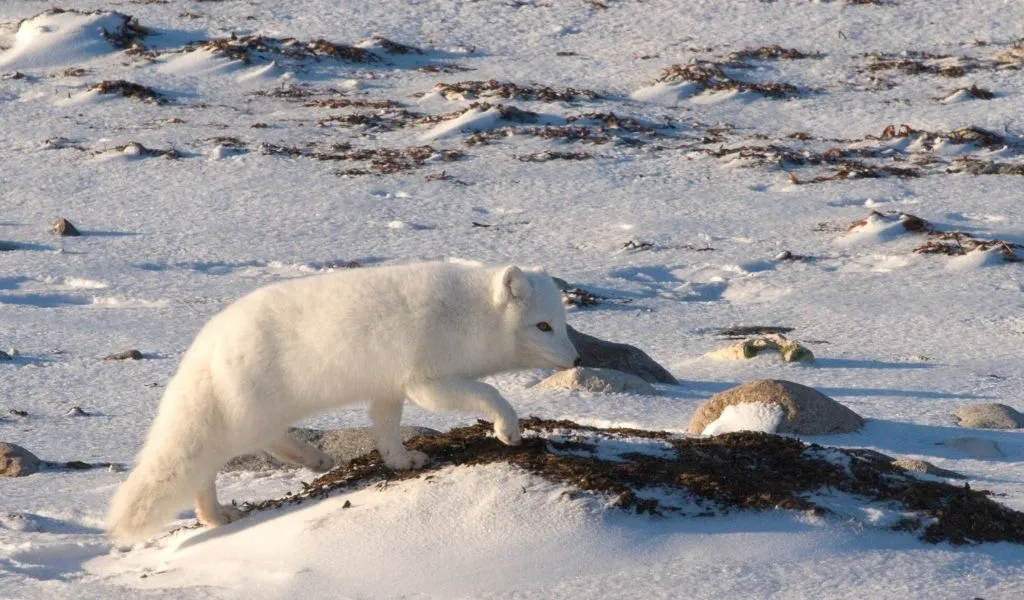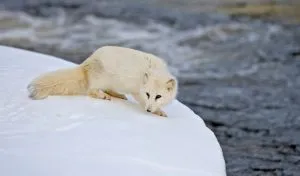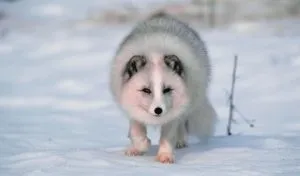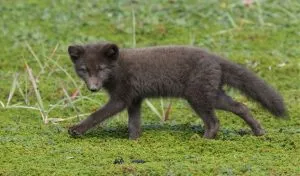Arctic foxes (vulpes lagopus) are one of the most interesting animals to study. They live in some of the harshest conditions on earth and have adapted incredibly well to survive there. Food supply can change from year to year and across different parts of the tundra. But, what exactly do arctic foxes eat?
Arctic foxes are not carnivores, they are omnivores. Their typical diet will consist of small mammals in inland areas and seabirds or fish in coastal areas. However, they will usually eat anything they can get hold of including berries, seaweed, carcasses, and feces of other animals.
In this article, we’ll look at the eating habits of arctic foxes, how they catch their prey, and how they feed their young.
Are Arctic Foxes Carnivores or Omnivores?
Although arctic foxes primarily eat animals such as lemmings, voles, and seabirds, they are in fact omnivores as they will also eat eggs, berries, and seaweed when their regular food is in short supply1 (source: Journal of Zoology, B. Elmhagen, et al, Vol 251, Issue 2, 2000).
The diet varies between those that live inland and those in coastal regions but more on this later.
They can often be described as opportunistic omnivores which are animals that will happily take any opportunity to feed that arises, no matter what food it is.
What Does an Arctic Fox Eat?
Arctic foxes have varied diets depending upon their habitat and will eat just about anything they can get hold of. There are two distinct diets of arctic foxes, that of inland foxes and that of coastal foxes.
Arctic foxes found inland will have a diet that mostly consists of rodents such as lemmings and voles, although will eat other small mammals and even carcasses of sheep or reindeer.
However, in coastal areas such as Iceland, they mainly eat seabirds, fish, ringed seal pups, and tidal invertebrates. In these areas, they will eat anything that the sea brings ashore2 (source: The Biology and Conservation of Wild Candids, D. W. Macdonald, and C. Sillero-Zubiri, 2004).
Those that catch their food in coastal areas will have a more stable food supply than those inland.
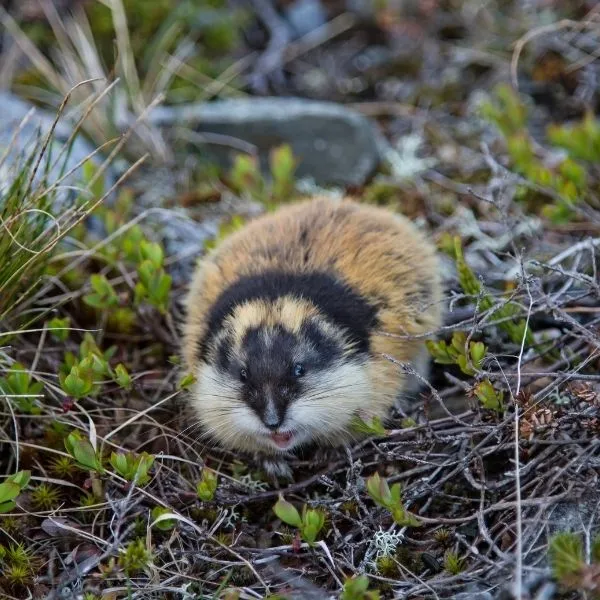
This is because lemmings and voles tend to flourish every three to four years when there could be as many as 3,000 lemmings per 100,000 square miles, compared to just 1 lemming in the same area during a downtime3 (source: BBC).
These fluctuations have consequences for the arctic fox population with most arctic foxes only expecting to see one season of abundant rodents in their lifetime4 (source: The Biology and Conservation of Wild Candids, D. W. Macdonald, and C. Sillero-Zubiri, 2004).
Changes in their food supply also impact their breeding habits which have resulted in two different reproductive strategies. Those with a stable food supply (coastal areas) will reproduce few cubs every year whereas those that see more changes in food supply (inland areas) produce larger litters but less frequently 5(source: Does Supplementary Feeding of Arctic Fox (Vulpes lagopus) in Norway Boost reproductive Success?, A. B. Stokkenes, 2016).
When food is scarce, arctic foxes will eat insects, eggs, berries, and seaweed. It’s not uncommon for arctic foxes to eat carcasses and feces of other animals such as polar bears.
When Do Arctic Foxes Eat?
Arctic foxes do not need to eat every day. If they are struggling to find food, they can dig a den where they can take a mini-hibernation for up to two weeks6 (source: National Geographic).
As they do not need to be on the lookout for predators, it allows them to slow down their heart rate and metabolic rate so that they can conserve energy. This is useful during periods of bad weather when it can be difficult to catch prey. This is similar to animals that hibernate, only for a shorter period.
How Much Does an Arctic Fox Eat?
There is little data to suggest how much an arctic fox eats, although some sources suggest that a family of 11 arctic foxes can eat up to 60 rodents per day through the summer months7 (source: Young Peoples Trust for the Environment).
When food is abundant, they will often bury it to consume later or to feed to their young.
Arctic foxes are renowned for storing excess food in the Earth or under stones in their den, oftentimes keeping in excess of 100 sea birds or enough food to feed a fox through the entire fall8 (source: Adaptations by the Arctic Fox (Alopex lagopus) to the Polar Winter, P. Prestud, Arctic, Vol 44, No. 2, June 1991).
How Big Do Arctic Foxes Grow?
Arctic foxes have adapted to the colder climates so they are smaller and stockier than the red fox. A typical arctic fox will weigh between 6-10lbs with a length of 43” including the tail9 (source: Alaska Department of Fish and Game, Accessed July 2021).
How Do Arctic Foxes Hunt?
Arctic foxes are well camouflaged, their coat changes color depending upon the season to help it blend in. They are white in winter to blend in with the snow and brown or grey in the summer. This allows them to sneak up on their prey without being seen.
Similar to other Canidae (species of dog), they have excellent hearing which allows them to hear the high-pitched sound that rodents make as they scuffle through the grass or snow.
The fox will stay completely still until it is sure of the exact position of the prey. Once it is sure, the fox will pounce by jumping up in the air and diving its head straight into the snow10 (source: How do arctic foxes hunt in the snow?, Colarado State University, Feb 2021).
Most arctic foxes do not migrate when food is scarce in winter, instead, they will take short 1-3 day trips to nearby sea ice where they will follow polar bears and feed off the carcasses of seals and other animals that they leave behind. Sometimes they will even eat the feces of the polar bears.
However, they must be careful, if the polar bear is struggling to find its regular prey, it may decide to hunt the arctic fox instead, although foxes are generally faster than polar bears.
In coastal areas where fish are a key food source, they will follow a similar hunting technique using shallow rock pools. Waiting until the optimum moment before throwing their head into the pool to grab the prey. They do not swim in the water to catch food.
A variant known as the blue morph arctic fox is common in coastal areas where there is less snowfall such as Alaska and Iceland. They do not grow a thick white winter coat like the common white morph which helps them blend in with their surroundings year-round11 (source: Dynamics of the Arctic Fox Population in Sweden, A. Angerbjorn et al, Annales Zoologici Fennici, Vol 32 Issue 1, 1995).
How Do Arctic Foxes Feed Their Young?
When the pups are young, the mother will stay with them to protect them from predators whilst the father goes out to hunt or scavenge for food.
As is common in the wild, arctic foxes begin weaning as soon as they grow teeth which is around 4 weeks old, they are fully weaned by 9 weeks12 (source: Polar Research, D. Berteaux. et al, Vol 36, Issue 1, Sept 2017).
Cub survival can be very low and in years where there is a low food supply, oftentimes none will survive at all13 (source: Adaptations by the Arctic Fox (Alopex lagopus) to the Polar Winter, P. Prestud, Arctic, Vol 44, No. 2, June 1991).
It has been suggested that there is fierce competition between siblings which can result in them killing and eating each other (siblicide). However, studies have debunked this myth14 (source: The effect of summer feeding on juvenile Arctic fox survival – A field experiment, Ecography, Vol 17, Issue 1, March 1994).
Where Do Arctic Foxes Get Water?
When they are first born, arctic foxes will drink their mother’s milk until they have been weaned (see information above). During the summer months, water sources are abundant so arctic foxes can easily drink from lakes, streams, ponds, rivers, and springs.
Most water sources freeze over in the cold winters so rather than bringing their body temperature down, they get most of their water from food sources instead15 (source: National Geographic).
What Are The Predators of the Arctic Fox?
The predators of the arctic fox include red foxes, polar bears, grizzly bears, wolves, golden eagles, and humans.
Red foxes are increasingly a concern for arctic foxes as climate change allows them to move further north and encroach on the territories previously inhabited by arctic foxes.
They prey on arctic foxes to eliminate competition for food sources such as rodents, this is known as intraguild predation.
Read our full guide for more information about each of the predators of the arctic fox.
Related Questions
Do Arctic Foxes Eat Polar Bears?
No, arctic foxes don’t prey on polar bears. Their prey tends to include small mammals, fish, and birds. Arctic foxes will often follow polar bears and feed off the seal carcasses they leave behind. Occasionally, arctic foxes will feed off their feces when food is in short supply.
Do Arctic Foxes Eat Penguins?
No, arctic foxes do not eat penguins because penguins are only found in Antarctica and not in the tundra or the arctic where arctic foxes live.
Do Arctic Foxes Eat Seals?
Yes, arctic foxes do eat seals. In coastal areas, they will often prey on ringed seal pups when they are confined to their den. Although they do not hunt seals, they will often follow polar bears and feed off the carcasses that they leave behind which will usually include seals.
Do Arctic Foxes Eat Humans?
No, arctic foxes do not eat humans, they prey on small animals such as rodents, sea birds, fish, and marine invertebrates. Arctic foxes tend to hide from humans if they come within a 200m range. However, those that are regularly around humans might become more tolerant of them.
You should still be cautious around them as they may attack if they perceive you to be a threat or if they are infected with rabies which can cause unnecessary aggression.
Do Arctic Foxes Eat Fish?
Yes, arctic foxes that live in coastal areas are known to eat fish along with other tidal invertebrates. Studies of arctic fox eating habits in Iceland found that as much as 80% of prey items in winter, spring, and summer were marine-based16 (source: Oecologia, Vol 99, Issue 3, Sept 1994).
In coastal Greenland, researchers spent 195 hours observing arctic foxes and found that their main food source was live caught fish. They do not get in the water to catch fish, instead, they would catch the fish at low tide by searching in rock pools or cracks17 (source: Fishing Arctic Foxes on a rocky island in West Greenland, S. M. Neilsen, 1991).
Do Arctic Foxes Eat Arctic Hares?
Yes, arctic foxes will eat any small mammals found in the tundra where they live, including arctic hares. However, arctic hares have a top speed of around 65kph18 (source: National Geographic) compared to an arctic fox’s top speed of 50kph so they will struggle to catch them.
Do Arctic Foxes Eat Lemmings?
Yes, arctic foxes eat lemmings, along with other rodents, in inland areas. However, lemmings are an unstable food source for arctic foxes because their population fluctuates substantially from year-to-year. Arctic foxes in coastal areas do not eat lemmings.


